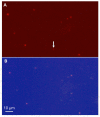Novel Synechococcus Genomes Reconstructed from Freshwater Reservoirs
- PMID: 28680419
- PMCID: PMC5478717
- DOI: 10.3389/fmicb.2017.01151
Novel Synechococcus Genomes Reconstructed from Freshwater Reservoirs
Abstract
Freshwater picocyanobacteria including Synechococcus remain poorly studied at the genomic level, compared to their marine representatives. Here, using a metagenomic assembly approach we discovered two novel Synechococcus sp. genomes from two freshwater reservoirs Tous and Lake Lanier, both sharing 96% average nucleotide identity and displaying high abundance levels in these two lakes located at similar altitudes and temperate latitudes. These new genomes have the smallest estimated size (2.2 Mb) and average intergenic spacer length (20 bp) of any previously sequenced freshwater Synechococcus, which may contribute to their success in oligotrophic freshwater systems. Fluorescent in situ hybridization confirmed that Synechococcus sp. Tous comprises small cells (0.987 ± 0.139 μm length, 0.723 ± 0.119 μm width) that amount to 90% of the picocyanobacteria in Tous. They appear together in a phylogenomic tree with Synechococcus sp. RCC307 strain, the main representative of sub-cluster 5.3 that has itself one of the smallest marine Synechococcus genomes. We detected a type II phycobilisome (PBS) gene cluster in both genomes, which suggests that they belong to a phycoerythrin-rich pink low-light ecotype. The decrease of acidic proteins and the higher content of basic transporters and membrane proteins in the novel Synechococcus genomes, compared to marine representatives, support their freshwater specialization. A sulfate Cys transporter which is absent in marine but has been identified in many freshwater cyanobacteria was also detected in Synechococcus sp. Tous. The RuBisCo subunits from this microbe are phylogenetically close to the freshwater amoeba Paulinella chromatophora symbiont, hinting to a freshwater origin of the carboxysome operon of this protist. The novel genomes enlarge the known diversity of freshwater Synechococcus and improve the overall knowledge of the relationships among members of this genus at large.
Keywords: Synechococcus; abundance; freshwater reservoirs; metagenomics; picocyanobacteria; smallest estimated size.
Figures





References
-
- American Public Health Association, American Water Works Association, World Powerlifting Congress Federation and Water Environmental Federation (1915). Standard Methods for the Examination of Water and Wastewater. Washington, DC: American Public Health Association.
LinkOut - more resources
Full Text Sources
Other Literature Sources
Miscellaneous

